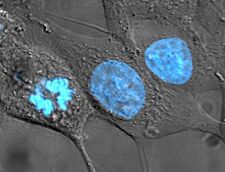HeLa Cells
HeLa Cells, is the cell line of human epithelial cells. They were removed in 1951 from Henrietta Lacks malignant cervical cancer. It turned out that they behaved like the so-called immortal cell line, so they are very invasive, they are still dividing and this has been continuously since 1951. HeLa cells have found commercial applications for their properties.
Henrietta Lacks[edit | edit source]
Born on June 1, 1920, she came from a poor black family, diagnosed with very progressive cervix uteri cancer in 1951, and died that same year. Before that, however, Dr. George Otto Gey took a sample of these cells and discovered their ability to divide rapidly and indefinitely, even compared to other cancer cells. As a result, these cells have found commercial uses and have survived Henrietta Lacks for more than sixty years.
HeLa cell caryotype[edit | edit source]
Later, scientists discovered that the heLa nucleus of cells contained an aneuploid set of chromosomes. While a normal human somatic cell contains 46 chromosomes, HeLa cells have 55 (three times they have chromosomes 6, 8, 17 and four times they have chromosome 12). But their constant multiplication is mainly made possible by the activity of the enzyme telomerase.
Discoveries using HeLa cells[edit | edit source]
- The first vaccine against Poliomyelitis anterior acuta-polio;
- medicines for AIDS;
- substance carcinogenicity testing
Links[edit | edit source]
References[edit | edit source]
- ALBERTS, B – BRAY, D – JOHNSON, A. Základy buněčné biologie. 2. edition. Espero Publishing, 2005. 740 pp. ISBN 80-902906-2-0.

